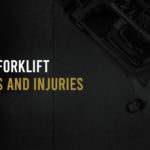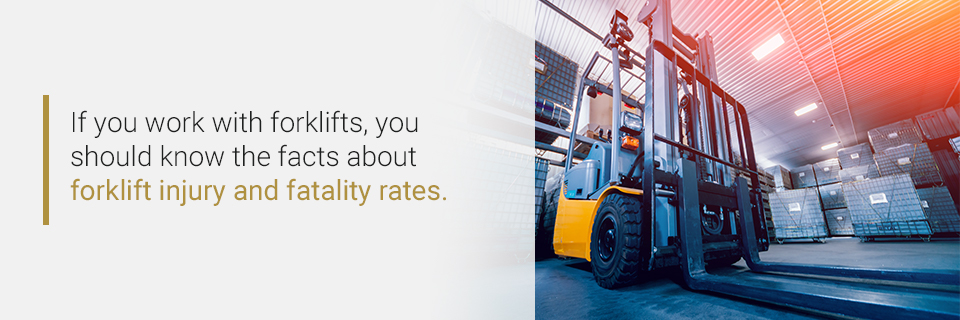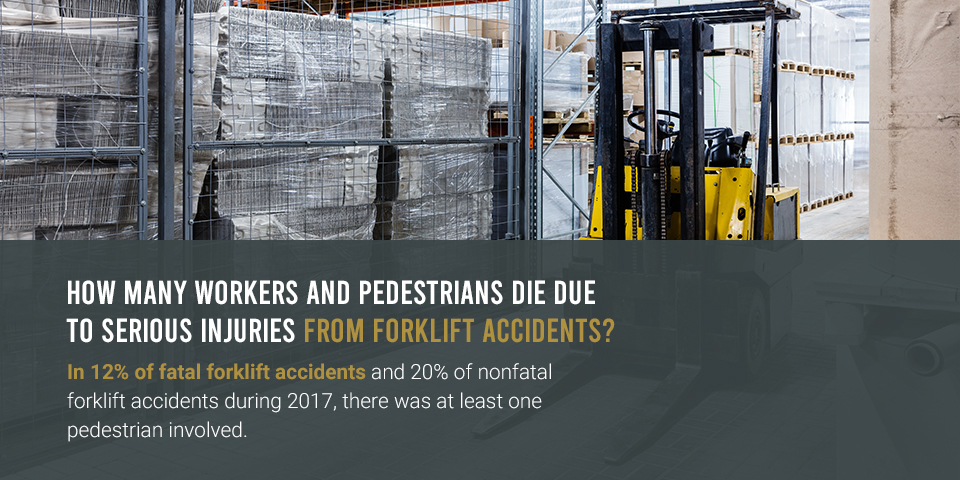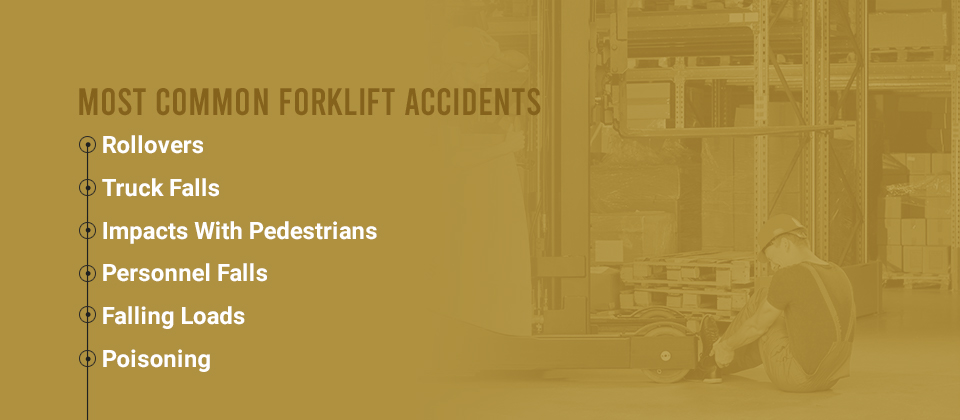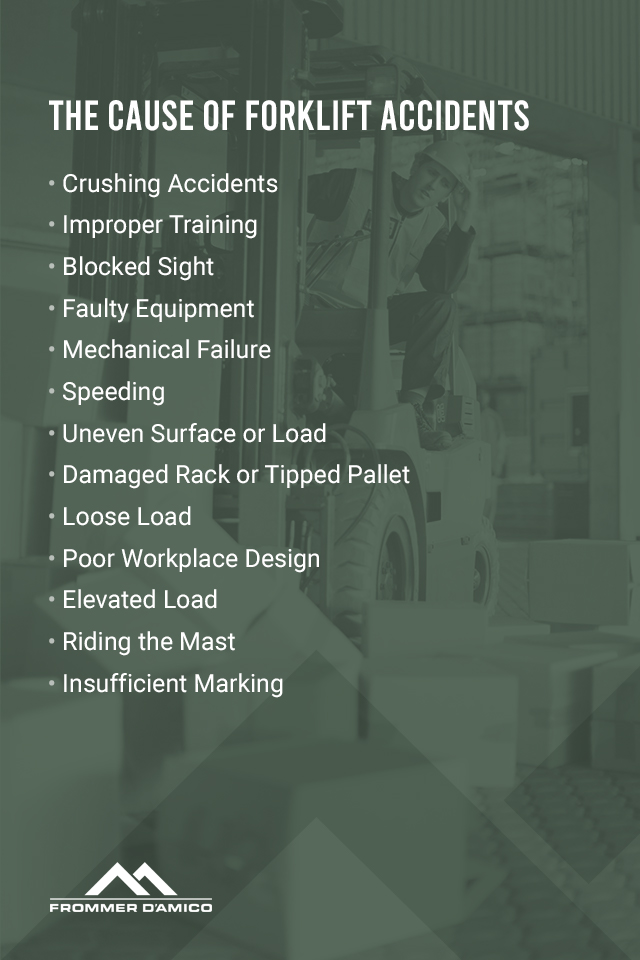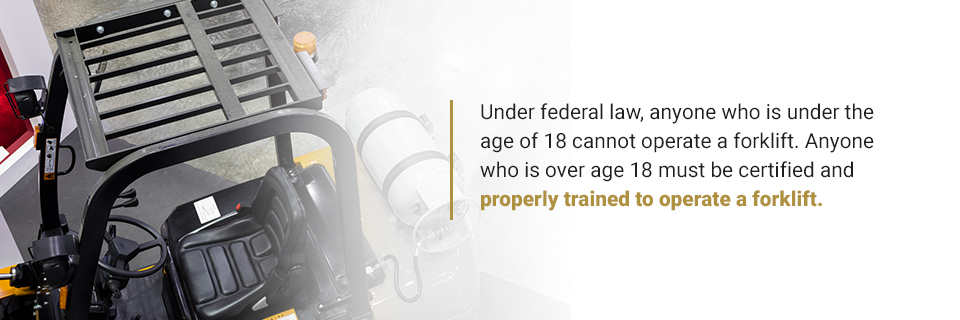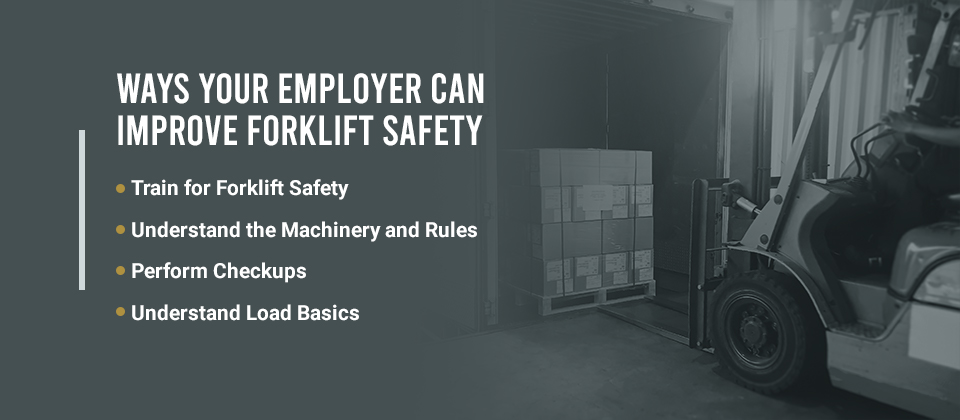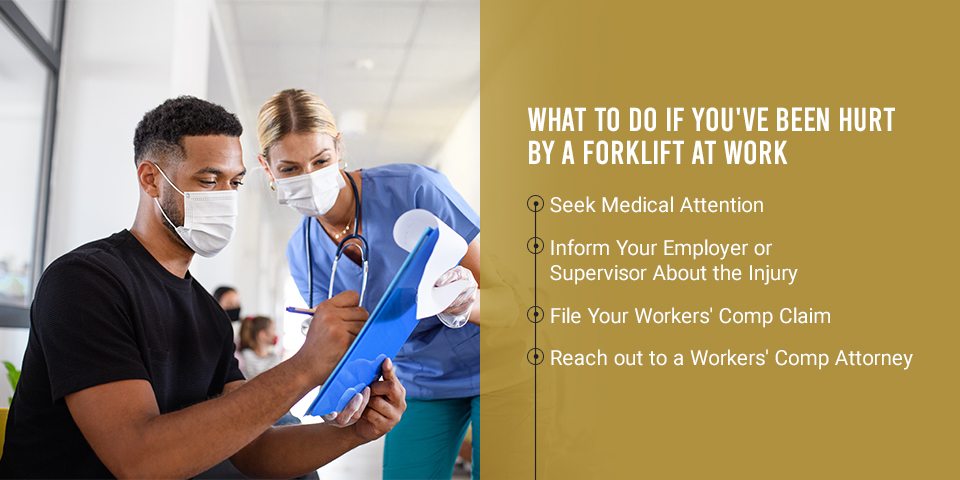Most Common Forklift AccideView Postnts and Injuries
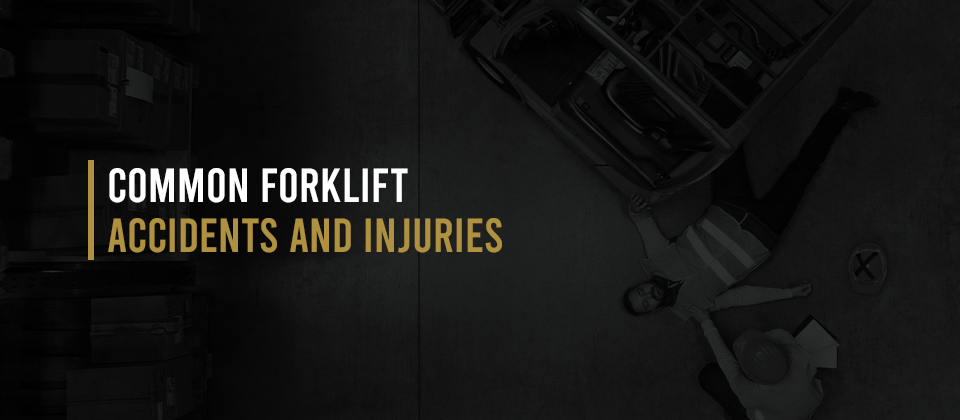
A forklift is mainly used in the workplace to transport and carry heavy materials in non-roadway areas. Powered platform trucks and order pickers fall under the forklift category. A forklift-related injury is also cross-categorized by the event type, typically as a transportation accident or an incident that involves contact with equipment or an object.
Forklift injuries often lead to medical expenses and days away from work for recovery. Each day, many workers operate powered industrial trucks, which are often a source of serious, and even fatal, injuries in the United States. If you are a forklift operator or you work around forklifts and have been injured in a forklift-related accident, you may be entitled to compensation.
How Dangerous Are Forklifts?
Forklift accident statistics illustrate how dangerous forklifts can be in the workplace. If you work with forklifts, you should know the facts about forklift injury and fatality rates.
How Many People Are Injured in Forklift Accidents?
According to the Occupational Safety and Health Administration (OSHA), 35,000 to 62,000 people are injured each year in accidents involving forklifts. According to the U.S. Bureau of Labor Statistics, there were more than 9,000 injuries related to forklifts in 2017 that were serious enough to force the injured workers to take time off. In 2018, this number dropped just below 8,000. In 2019, there were more than 8,000 nonfatal forklift injuries that resulted in days off work.
Injuries caused by forklifts are often more severe than other workplace injuries. While the median amount of time a worker takes off work for other workplace injuries is eight days, for forklift injuries, the median amount of time injured employees take off work is 16 days.
How Many Workers and Pedestrians Die Due to Serious Injuries From Forklift Accidents?
Every year, almost 100 workers die as a result of forklift accidents in the United States. About another 20,000 people suffer serious injuries from forklift-related accidents. Between 2011 and 2017, there were 614 fatalities due to forklift accidents. There were 79 forklift deaths in 2019, 54 deaths in 2017 and 71 deaths in 2015.
Though the numbers change year to year, pedestrians are commonly involved in nonfatal and fatal forklift accidents. In 12% of fatal forklift accidents and 20% of nonfatal forklift accidents during 2017, there was at least one pedestrian involved.
Most Common Forklift Accidents
Forklifts are small industrial trucks used in storage facilities or warehouses to lower or raise an object like a pallet or to move goods. Depending on the type of forklift, it can be controlled by an operator who walks beside it or rides it. Due to the size of this machinery, forklift accidents can often result in serious injuries and fatalities. The most common forklift accidents include the following:
1. Rollovers
The most common forklift accident is a rollover. Forklift operators who feel the forklift tipping over should remain in their seat, which is the safest place in the forklift. Then they should lean away from the impact point and brace themselves. Those operating stand-up forklifts should exit the operator compartment and step away from the truck. Be sure to always wear a seatbelt. Rollovers are often caused by:
- Abrupt turns
- Elevated load
- Uneven surface
- A turn on an incline
- Abrupt mast movement
- Unbalanced, uneven or overweight loads
To avoid a rollover, take precautionary steps. Follow the speed limits set by OSHA, exercise caution when you tilt a raised mast, go slowly when turning a corner, keep the load low to the ground, avoid exceeding the lift’s capacity, operate only on even, smooth surfaces and avoid turning on inclines.
2. Truck Falls
Among some of the most dangerous activities to perform on a forklift is crossing a threshold. Whether this means moving in and out of a semi-trailer or between areas in a warehouse, as a forklift operator, you should be vigilant in ensuring it is safe to proceed. The main causes of truck falls include:
- Slippery floors
- Trailers or trucks rolling away
- No dock plate or improper dock plate
- Damaged or worn trailer or truck floors
You may be able to prevent a truck fall by securing the trailer or truck wheels before you enter, inspecting the trailer or truck floor before driving on it and slowing down when you approach the dock.
3. Impacts With Pedestrians
Employees are often working on foot near forklifts that are being operated. As a result, many forklift accidents involve pedestrians. Pedestrian impacts are typically caused by a lack of warning signals and signs or operator inattention due to fatigue, carelessness and distracted driving.
To prevent a pedestrian impact, you may want to take more breaks that will help you avoid fatigue or distracted driving. If a pedestrian is nearby and next to another object, exercise extra caution to avoid pinning the pedestrian between the forklift and the object. Use barriers and floor tape, which can mark the areas that pedestrians should avoid.
4. Personnel Falls
Though it can be tempting to stand on forklifts for the sake of convenience, no one should stand on the forks. If this happens, the chance of a fall occurring is very high. A fall from this height can lead to internal bleeding, broken bones, head trauma and impalement. A few of the main causes of these falls include a lack of aerial lifts, unrestrained or unapproved lifting platforms and prioritizing convenience and speed over safety.
Fortunately, you may be able to prevent a fall by using the proper equipment, using lifting cages that are OSHA-compliant, slowing down and not cutting corners.
5. Falling Loads
As a forklift operator, you may not always be tasked with carrying simple loads like pallets and boxes. Often, your job will involve transporting and lifting other loads, such as raw materials and small items that can fall if they are not secured properly. A falling load can be a hazard to both operators and pedestrians.
Falling loads are commonly caused by bent forks, no load backrest, improper load creation and lifting, tilting or moving the mast too quickly. To prevent injury and forklift death, everyone in the workplace should take care to make sure loads are stable on the forks. You can also:
- Center the load
- Conduct pre-trip inspections before each shift
- Avoid carrying damaged or loose merchandise
6. Poisoning
While a battery-powered forklift is quickly becoming the preferred option for many companies, internal combustion forklifts remain in wide use. Fortunately, progress in emissions technology has led to fewer emissions from internal combustion lift trucks.
Operating these trucks may still create hazards for employees. Carbon monoxide poisoning from emissions can be a result of poor ventilation, leaking exhaust, incorrect fuel mixture, excessive idling and operating in a confined space. Emissions poisoning can be avoided via the installation of ventilation systems and carbon monoxide monitors, awareness of the risks associated with confined spaces and scheduled maintenance.
The Cause of Forklift Accidents
Even with awareness and safety precautions in place, forklift accidents can still happen. Below are some of the top causes of forklift accidents and injuries.
1. Crushing Accidents
Among the most common causes of forklift accidents are crushing hazards. Crushing accidents often lead to forklift injuries and fatalities, particularly for pedestrians, as they can be pinned between a fixed object and the truck if an operator is not paying attention. These accidents tend to be caused by loose materials falling from a fork, the mast tilting and inattentive backing.
You may be able to prevent a crushing accident by properly securing the load and scanning your surroundings before you put a forklift in motion, along with not driving up to pedestrians who are next to fixed objects and not leaving the operator’s compartment while operating the forklift.
2. Improper Training
Lack of training for operators is a frequent cause of forklift accidents. Forklift operators need proper training to understand how to effectively and safely use this machinery. Though you must be trained and certified prior to using a forklift, this does not always happen. If you operate a forklift without knowing the proper safety procedures and policies, an accident is more likely to occur. Fortunately, inadequate or improper training is easy to correct.
Improper training may be a result of supervisors or managers who are not aware of the training laws or companies that want to cut corners to save time and money. To ensure you are properly trained in operating a forklift, talk to your employer about signing up for training that is OSHA-compliant.
3. Blocked Sight
If you cannot see where you are going while operating a forklift, this can lead to an accident. Tall or elevated loads can decrease visibility, and forklifts also have blind spots on the sides and to the rear that can lead to collisions with equipment, products, infrastructure and pedestrians.
You may be able to avoid accidents due to blocked sight by having a co-worker be your spotter, traveling only in a visible direction, paying attention to your surroundings and keeping forks close to the ground.
4. Faulty Equipment
Another common cause of forklift accidents is faulty equipment, especially when there is a lack of the tools needed to repair a faulty machine. Improper attachments, incorrect accessories, faulty steering wheels and a lack of parts can also contribute to forklift injuries. Any attachments and accessories should be secured properly to prevent detaching or slipping.
Faulty parts should be replaced or repaired, and a forklift should be inspected and maintained daily prior to and following operation of the machine.
5. Mechanical Failure
A forklift is like any other machinery in that it needs to be regularly maintained. When a forklift is neglected, safety issues and breakdowns are likely to occur. Mechanical failures may include damaged or worn tires, leaks and worn brakes. To avoid mechanical failures, conduct an inspection before you begin operating the forklift, pull equipment until any issues are corrected and service your equipment regularly.
6. Speeding
A forklift is not intended for speed. Instead, the machine is designed to lift and transport heavy objects. Unfortunately, some forklift drivers may drive faster than recommended and disregard the potential danger or be unaware of the dangers that speeding can pose. This can quickly lead to forklift injuries or fatalities in the workplace.
7. Uneven Surface or Load
An uneven load or surface can lead to a forklift toppling over. If a load is too heavy or the forklift travels over steep slopes, drains or potholes, this can also cause the forklift to tip over. To prevent this from happening, double-check the surface and the load.
8. Damaged Rack or Tipped Pallet
Lifting and setting down a pallet can be a challenge. The less visibility there is, the more likely it will be that the pallet will get knocked off and the tip of the tines may damage the racking or the product.
As a forklift operator, you can prevent this by resetting the tines to a more level position or installing a mast camera that has an operator monitor, allowing you to view what is taking place on the high racks.
9. Loose Load
When a load is loose, it can fall from the tines and mast, especially if it is loosely packed or unbalanced. Depending on the load’s weight, this may cause serious injury or even death to a victim. Before you move a load from one location to another, ensure it is stable to prevent an accident from occurring.
10. Poor Workplace Design
In a warehouse with narrow aisles, it can be challenging to navigate and maneuver a forklift. Even in aisles designed for easy maneuvering, the smallest amount of clutter can cause an accident if you try to avoid this obstacle.
Poorly designed warehouses can also lead to a high volume of traffic the space is incapable of handling. Other issues that may arise include:
- Poor lighting
- Loud noises
- Uneven surfaces
Even poor cleaning can negatively impact forklift operation and performance. A poorly designed workplace can easily lead to forklift accidents and injuries.
11. Elevated Load
If a load is higher than the center of gravity, it will not be stable or balanced and may pull down the item to which it is attached. With forklifts, this occurs often, which is why regulations are in place to encourage forklift operators to carry heavy loads as close to the ground as they can.
12. Riding the Mast
In some cases, workers may sit or stand on the forklift masts, though this should not happen under any circumstance. Anyone who stands or sits on the mast can easily fall and possibly be run over by the forklift, which could lead to severe forklift injury or deaths.
13. Insufficient Marking
Insufficient floor marking may also lead to accidents. Markings should be clear and highly visible to warn forklift operators, pedestrians and warehouse staff about the dangers in the area. A forklift operator also needs to be sure to follow these warning signs.
OSHA Regulations Regarding Forklift Safety
Following OSHA regulations for forklift safety can help prevent workplace accidents and injuries. Under federal law, anyone who is under the age of 18 cannot operate a forklift. Anyone who is over age 18 must be certified and properly trained to operate a forklift. OSHA safety regulations include requirements related to fire protection, maintenance and design, such as:
- Approved trucks need a label or another identifying mark to indicate approval from a testing laboratory.
- Additions and modifications that affect safe operation and capacity should not be performed without prior written approval from the manufacturer.
- Power-operated industrial trucks should not be used in an atmosphere that contains a hazardous concentration of hydrogen, butadiene, acetylene, ethylene oxide, acetaldehyde, propylene, cyclopropane, isoprene, unsymmetrical dimethylhydrazine, diethyl ether or metal dust.
Forklift operators and employers should be aware of and adhere to OSHA safety regulations for powered industrial trucks.
Ways Your Employer Can Improve Forklift Safety
Below are some of the ways employers can actively ensure employee safety around forklifts.
1. Train for Forklift Safety
Ensuring worker safety starts with proper forklift training. Someone who is not properly trained to operate a forklift can be just as dangerous as someone who is unlicensed driving a motor vehicle. OSHA training requires formal instruction, practical training and an evaluation of workplace performance.
2. Understand the Machinery and Rules
To ensure workplace safety, employers should understand the different types of machinery used in the warehouse, along with the similarities and differences that impact how to safely operate them. Employers should inform employees about the safety rules and enforce them, including wearing seatbelts and maintaining visibility.
3. Perform Checkups
Employers should encourage forklift operators to inspect the forklift before operating it, looking for issues that can be spotted without the engine running. Checkpoints include:
- Horns
- Lights
- Brakes
- Seatbelts
- Fluid levels
- Moving parts
- Backup alarms
- Front and rear wheels
- Load-supporting parts
Forklifts should also be maintained and kept in good working condition.
4. Understand Load Basics
Before employees pick up a load with a forklift, they should check it and ensure it is stable and the dimensions are conducive for safe transport. Employers should instruct you on load basics, such as moving squarely in front of a load and moving the forks apart before driving the forklift to lift the load.
What to Do if You’ve Been Hurt by a Forklift at Work
Follow the steps below if you have been hurt at work by a forklift.
1. Seek Medical Attention
First, seek medical attention as soon as possible to deal with your injury. If there is an on-duty nurse at your facility, see them immediately. If the injury is more serious, request emergency medical care. Let every medical professional know that you suffered a work-related injury, as this is essential for your workers’ compensation claim when you file.
2. Inform Your Employer or Supervisor About the Injury
Next, you should notify your employer or supervisor about your injury. Though you are allowed 120 days in Pennsylvania to notify your employer after your injury, it is best to do so as soon as possible. Particularly if you want workers’ compensation benefits, you should report your injury within 21 days.
3. File Your Workers’ Comp Claim
After reporting your injury, you can file your workers’ comp claim so you can receive benefits during your recovery. If your claim is accepted, you will begin receiving benefits. If your claim is denied, you may need to seek assistance from a workers’ comp attorney.
4. Reach out to a Workers’ Comp Attorney
If you have been denied benefits or you believe you are not receiving the benefits you are entitled to, reach out to a workers’ compensation attorney who can help you navigate the legal process of appealing the decision.
Contact Frommer D’Amico if You Have Been Hurt at Work
At Frommer D’Amico, our attorneys can assist you with any workers’ compensation challenge you are experiencing. Our workers’ comp services are comprehensive and involve personal attention for all clients.
We can be reached 24/7, and we handle cases in Central Pennsylvania. We will travel to areas such as Allentown, Altoona and Scranton to serve the clients who need us. We also do not charge to manage your claim if it is not in court. Contact us at Frommer D’Amico if you’ve been hurt at work by a forklift.
